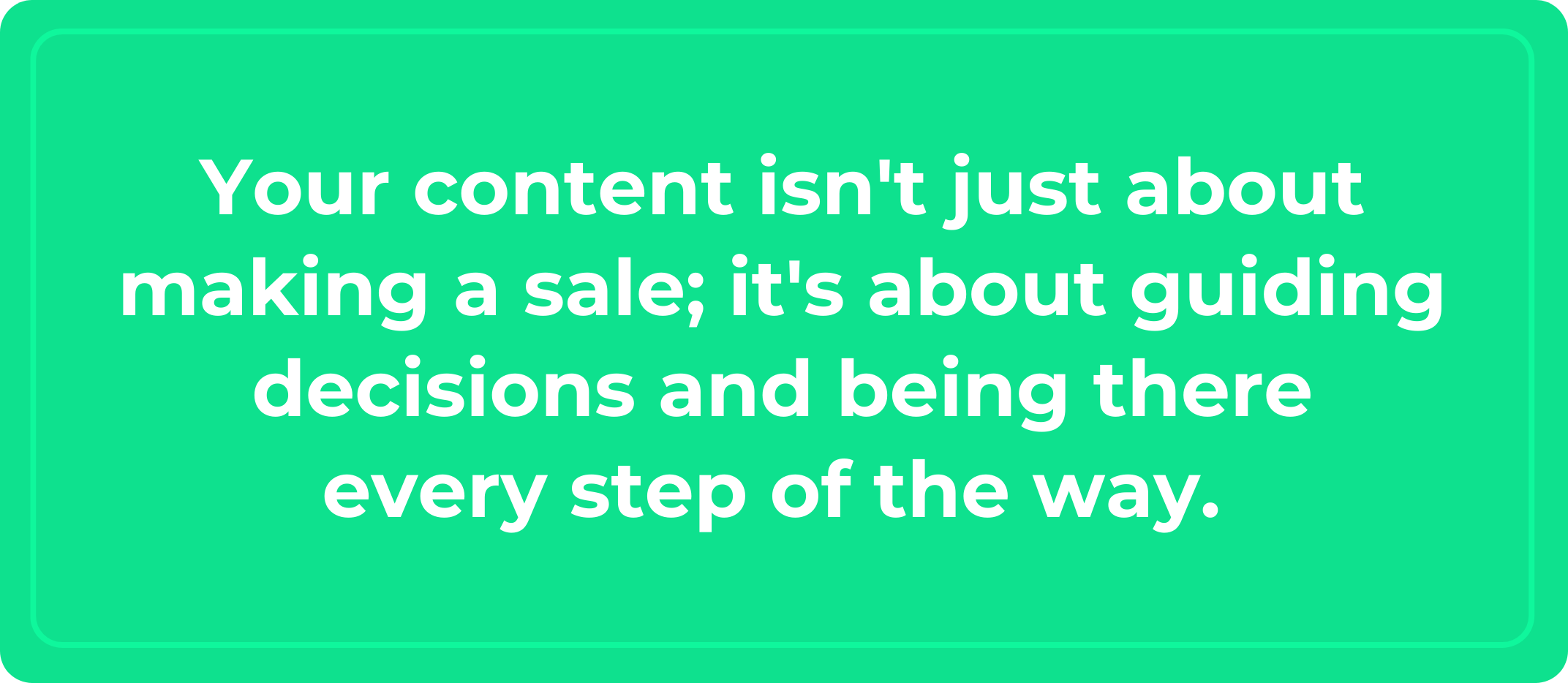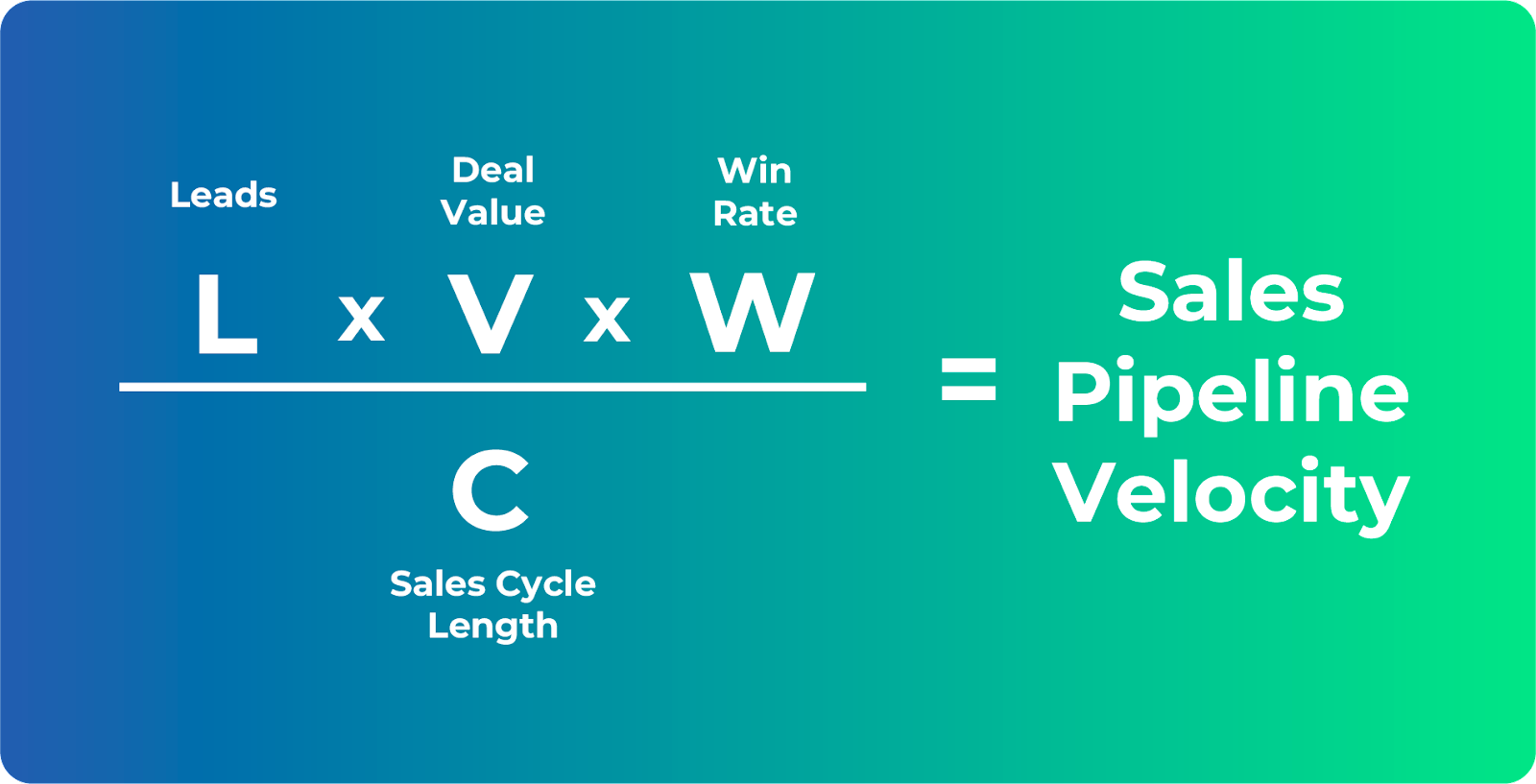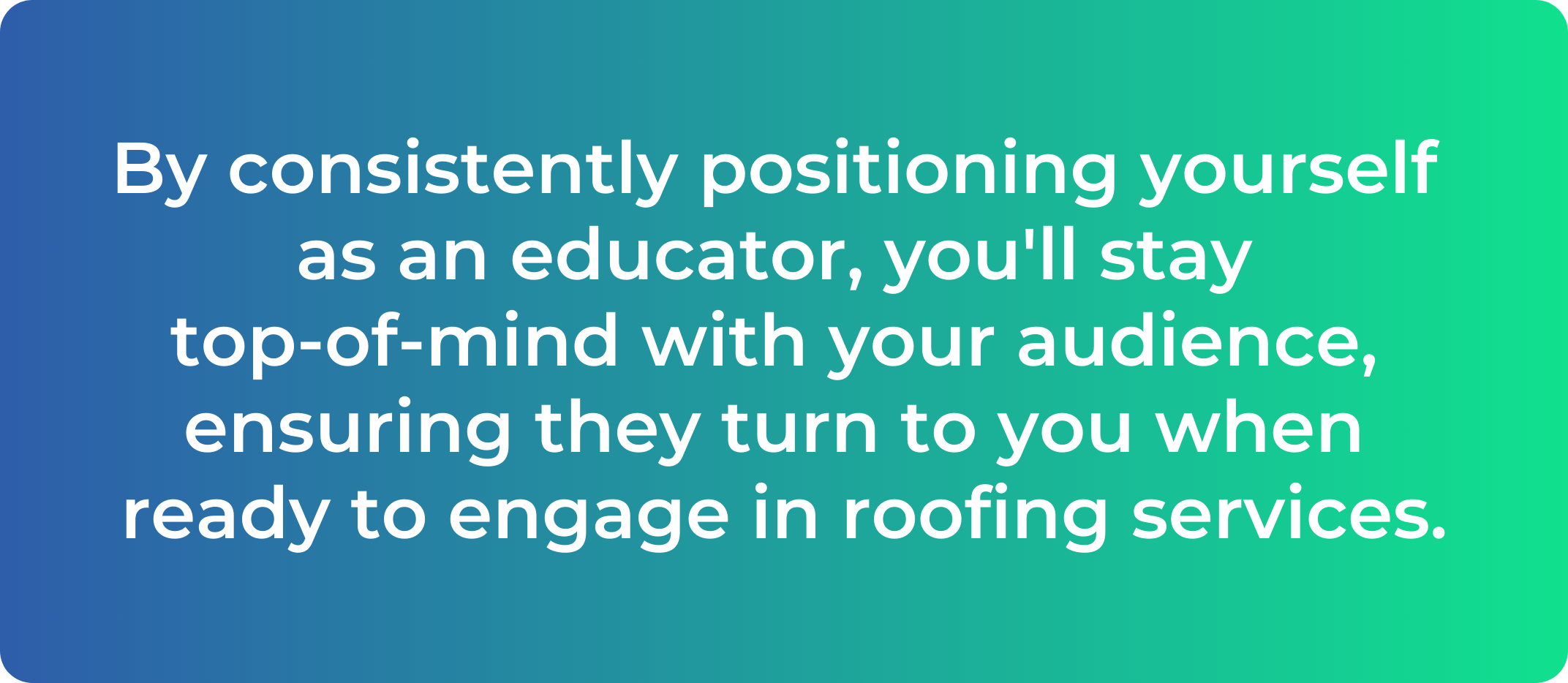Share this
Aligning 'They Ask, You Answer' with Demand Generation for Roofing
by Eliza Spain on Dec 11, 2023

In the roofing industry, the significance of impactful content reigns supreme. It's not just about showcasing services; it's about crafting narratives that resonate, educate, and inspire action.
Compelling content isn't merely words on a page or images on a screen; it's the bridge that connects roofing expertise with customer needs. It's the tool that educates homeowners on the complexities of roofing solutions, guiding them toward informed decisions.
In an industry where trust and reliability matter most, content isn't just an accessory—it's the cornerstone of establishing credibility, fostering connections, and standing out amidst the competition.
Before we jump into the specifics of content creation, let's take a moment to understand what demand generation and 'They Ask, You Answer' mean in the context of the roofing industry.
Demand Generation & 'They Ask, You Answer'
Demand generation creates interest and awareness about your roofing products or services. As a broad marketing strategy, it aims to attract potential customers, nurture leads, and guide them through their buyer's journey until they become paying customers.
Now that we've established demand generation let's align it with the principles of They Ask You Answer (TAYA). This concept, popularized by Marcus Sheridan and utilized by his company IMPACT, emphasizes the power of addressing your audience's questions and concerns through valuable and transparent content.
It is based on the idea that if your customers ask questions, you should be able to answer them openly and honestly…because educated prospects are happier, better customers.
Implementing this approach can build trust, establish authority, and convert potential customers into loyal advocates.
Demand generation encompasses all of TAYA, but what sets it apart is that it goes beyond just answering your customers' common questions; it includes various strategies for effective advertising (such as social media, local SEO, and Google Guarantee).
Aligning They Ask, You Answer with demand generation in the roofing industry involves a strategic blend of demand capture and creation. In this context, it's about understanding that potential customers often have roofing-related problems or queries and are looking for a solution.
Roofing businesses can establish themselves as authoritative sources by answering common questions prevalent in the industry. This involves employing long-tailed keywords (like “roof replacement costs” or "local roofing services near me”) and optimizing content to address these queries directly. By catering to the audience's existing problems and concerns through insightful content, roofing companies can effectively capture and create leads, driving demand by offering valuable, sought-after information.
Now that we have given you a brief overview of TAYA and demand generation, let's take a look at what you will find throughout this article:
- Identifying roofing FAQs and pain points
- Crafting informative and engaging content
- Best practices to follow
- Measuring your content’s success
- Tools & technologies
- Leveraging channels to promote content
- Mistakes you can avoid
Identifying Roofing FAQs and Pain Points
The first step in creating content that creates a better buying experience is to identify your target audience's frequently asked questions (FAQs) and pain points. Put yourself in their shoes and think about their doubts, fears, or uncertainties regarding roofing projects. Utilize keyword research tools, online forums, and social media platforms to uncover people's most common queries.
When it comes to crafting content that clicks with roofing audiences, there are also a few hurdles that companies often face.
First off, it's the balancing act between educating and selling. Sure, we want conversions, but it's not just about turning heads; it's about enlightening in a way no one else does. It's about becoming the go-to source people trust and building a lasting relationship.
Here's the kicker: more conversions don't necessarily mean more sales. That's why we're all about educating.

Speaking of conversions, it's more than just any kind of conversion you should be after. We're not just talking about any clicks, but the right kind—the ones that truly matter, like those who want a quote or are ready to connect, not just folks downloading an ebook and disappearing into the digital abyss.
That's the magic of your content—it's not just fluff; it's a helping hand in your customers' roofing decisions.
Crafting Informative and Engaging Content
Once you have a robust list of FAQs and pain points, start crafting content that addresses them head-on. Your content should be informative, engaging, and easy to understand for the average reader. Break down complex roofing concepts into digestible chunks, incorporate visuals, and sprinkle a touch of personality to make your posts relatable.
The secret to crafting demand-worthy content is getting into the fine details of what your audience wants to know. Start by tuning in and jotting down those everyday questions that keep popping up. Wherever these questions are thrown around—online forums, chats, or even during casual conversations—make it a habit to document them all.
Remember: answering questions isn't a one-time deal. There are multiple angles to consider different twists and turns for various situations. So, gather those questions, get creative, and determine the answers that make your audience go, "Wow, these guys get us!" That's the recipe for content that turns heads and, better yet, prompts action!
Best Practices to Follow
Crafting content that seamlessly guides potential customers toward conversion requires a strategic approach. Here are some of the ways we suggest that you take on and add to your sales and marketing strategy to create a better buying experience:
- Educational Content: Create content that isn't just about pitching but educating. By addressing common questions and offering valuable insights, you position your brand as a reliable source of information.
- Answering Customer Questions: Dive into customer questions head-on. You establish trust and credibility by providing precise and comprehensive answers, nudging them closer to a purchasing decision.
- Buying Guides: A must-have! Every roofing company should develop its version of a buying guide. This comprehensive resource helps customers navigate their choices and solidifies their authority in the industry. Holladay Grace (a Roofing Demand client) is an excellent example of how you can successfully showcase a buyer guide on your website. This content answers your customers' questions to allow them to make the best purchasing decision for their roofing needs, available anytime they need it.
- Sales Alignment: Ensure your sales team knows the content you're creating and how it can aid their sales process. Equip them with the knowledge to leverage content effectively during interactions.
- Educational Focus: Remember, it's about educating to empower customers’ purchasing decisions. The more informed your audience, the more confident they'll feel about choosing your services.
- Video Content: Show, don't just tell. Video content engages and educates in a more captivating manner. Consider having videos on various website pages to explain processes, showcase work, and build a connection with your audience.
Take a closer look at the types of videos you can incorporate into your website:
- FAQs
These videos are designed to answer the top 80% of questions your customers or prospects have about your product or service. They can be a great way to provide helpful information and build trust with your audience. - Employee Feature
Use video to introduce your team and showcase their expertise and personality. This can build trust with your audience and make your brand feel more approachable. - Landing Page
Use video on your landing pages to grab attention, convey key messages, and drive action. LP videos can be especially effective for complex products or services that require more explanation. - Cost or Pricing Information
Use the video to explain your pricing model and the factors that affect pricing. This can help address common objections and make it easier for prospects to understand the cost and benefits of working with you. - Showcase Products and Services
Create videos that showcase the features and benefits of your products or services. This can bring your offerings to life and make it easier for prospects to understand how they can benefit from working with you. - Success Stories
Use video to showcase your customer journey and highlight critical touchpoints. This can help build trust with your audience and demonstrate your commitment to delivering a great customer experience. - Support Claims About a Product or Service
Use videos to back up your claims with real-world examples and proof points. This can help build credibility with your audience and demonstrate that your product or service works.
By following these strategies and incorporating educational, informative content across various mediums, you're not just selling but building lasting relationships based on trust and reliability.
Essential tip: Don't limit yourself to just written content. The power of video in demand generation must be considered. Consider creating short videos that answer specific roofing questions or showcase your work. Videos enhance engagement and allow you to establish credibility and build rapport with your audience.
Related: Overcoming Internal Hurdles: Video Marketing in the Roofing Industry
Measuring Your Content’s Success
Roofing companies can gauge their content's impact on demand generation and conversion by assessing key metrics.
Observing the speed at which leads progress through your sales pipeline post interaction with particular content reflects Sales Pipeline Velocity. This metric gauges how swiftly potential customers advance toward conversion after engaging with your materials.

More Qualified Opportunities/Leads indicate the rise in superior leads or prospects generated through interactions with your content. These are high-quality leads displaying more significant potential for conversion or engagement with your roofing services.
Increasing Win Rate signifies whether your content positively influences the rate of conversions or wins from potential leads. This metric provides insights into how effectively your content drives potential customers toward becoming paying clients.
Higher Deal or Contract Value allows you to assess whether engaging with your content leads to securing higher-value contracts or deals. It measures the impact of content interactions on the value of contracts finalized.
Shorter Sales Cycle Duration tracks the reduction in the time taken from the initial contact to finalizing a sale due to interactions with your content. This metric reflects how content engagement expedites the initial interest in the purchasing process.
Content effectiveness can also be exemplified through practical scenarios.
Ask yourself: Is my content helping us gain more qualified leads, increase win rates, achieve a higher deal or contract value, and shorten the sales cycle?
Observe how this information influences decision-making.
For example: Are customers expressing more interest? Are there increased inquiries or engagements regarding a piece of content you created about choosing the right roofing material?
By observing these metrics alongside content initiatives, roofing companies can effectively measure the impact and success of their content in driving demand and conversions.
Tools & Technology
Tools like HubSpot offer a suite of functionalities across their Marketing Hub, Sales Hub, and Customer Service Hub (and more) that can immensely aid roofing companies in optimizing their content for conversion.
Take a closer look at what each of these tools can offer:
- HubSpot Marketing Hub: This tool enables companies to effectively create, manage, and track their content marketing efforts. It provides content creation features, SEO optimization, social media scheduling, and email marketing—all essential elements to drive engagement and conversion.
- HubSpot Sales Hub: The Sales Hub assists in aligning sales strategies with content initiatives. It provides tools for lead tracking, email tracking, and personalized outreach, enabling sales teams to leverage content effectively during interactions, ultimately contributing to higher conversions.
- HubSpot Customer Service Hub: Post-conversion, the Customer Service Hub comes into play. It helps maintain customer satisfaction and retention by providing tools for managing support tickets, creating knowledge bases, and facilitating seamless communication, ensuring a positive post-purchase experience.
By utilizing these HubSpot tools collectively, roofing companies can streamline their content strategies, nurture leads more effectively, and create a cohesive customer journey—ultimately optimizing content for higher conversion rates.
Leveraging Channels to Promote Content
Roofing companies can harness social media and email marketing channels to amplify content and stimulate demand.
Use platforms like Facebook, Instagram, LinkedIn, YouTube, and Twitter to share content and educate your audience. Often, just creating content isn't enough—utilize social media as a distribution avenue to reach a wider audience.
Educate your followers with valuable insights and information, positioning your brand as a trusted educator. This strategy ensures that when your audience is ready to purchase, they think of you as the go-to expert.
Related: Mastering Social Media: Tips for Roofing Companies
Leverage your email list to circulate your content directly to your subscribers. Craft engaging newsletters or email campaigns that share your content and educate your audience about roofing-related topics. Be consistent in providing valuable information, fostering a perception of your brand as an educational resource.
The key across these channels is to maintain a consistent educational approach.

Mistakes You Can Avoid
Here are some common pitfalls roofing companies should steer clear of when converting content and generating demand:
- Lack of Consistency: Not having a dedicated individual responsible for consistently producing content can hinder the creation of a steady stream of valuable material. Consistency in content creation is crucial for maintaining audience engagement and trust.
- Focusing Solely on Conversion: Trying too hard to create content geared towards immediate conversion can backfire. Content should aim to educate and resonate with your audience rather than being solely sales-oriented.
- Quantity Over Quality: While producing regular content is important, focusing solely on quantity while maintaining quality can hurt your efforts. Strive for a balance between regularity and excellence in content creation.
- Unclear Content Purpose: Creating content without a clear purpose or strategy can confuse your audience. Define your content's purpose—educating, engaging, or guiding customers—before crafting it.
Related: Why You Need to Invest in A Content Manager (and How to Hire One)
Roofing companies can effectively engage their audience and drive meaningful demand by avoiding these pitfalls and adopting a consistent, value-driven approach to content creation.
Conclusion
Aligning They Ask, You Answer principles with demand generation strategies isn't merely a one-time task—it's an ongoing commitment to staying customer-centric in roofing marketing efforts.
By embracing this approach, roofing companies address customer queries and forge connections built on trust and transparency.
Remember, successful content marketing is a journey that requires continuous learning and adaptation. Stay current with industry trends, analyze your content performance, and refine your approach to attract and convert roofing leads.
Have questions? We would love to hear from you and assist you in creating a better customer buying experience.
Take some time to reach out and talk with an experienced advisor today!

No Comments Yet
Let us know what you think